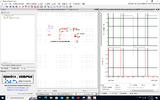Saeedk9574
New Member
Hi everyone
I am using a common anode 4 digit 7 segment to show the time, but the problem is whenever I increase voltage above 3.8v All LEDs of the 7 segments gets lighted up and the correct number can not be seen
I have connected the common pins (A-G) of 7 segments to the PNP transistor, and the common pins connected to 300-ohm resistor.
I am using a common anode 4 digit 7 segment to show the time, but the problem is whenever I increase voltage above 3.8v All LEDs of the 7 segments gets lighted up and the correct number can not be seen
I have connected the common pins (A-G) of 7 segments to the PNP transistor, and the common pins connected to 300-ohm resistor.


